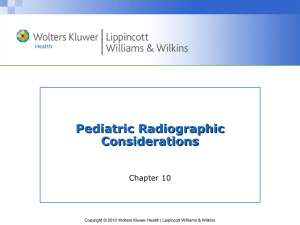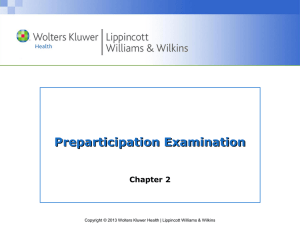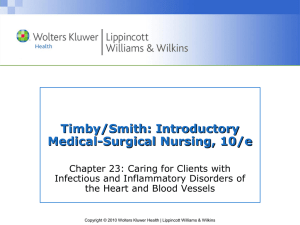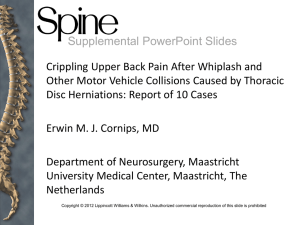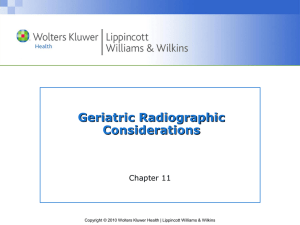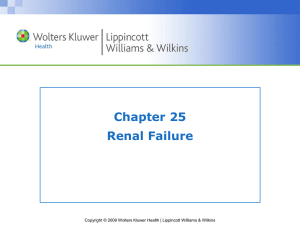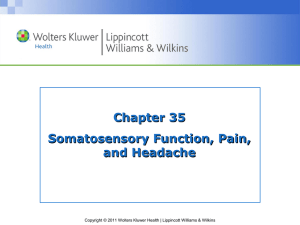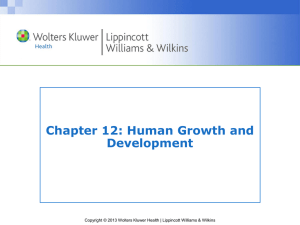Ch 16 - Motivation - Biology Courses Server
advertisement
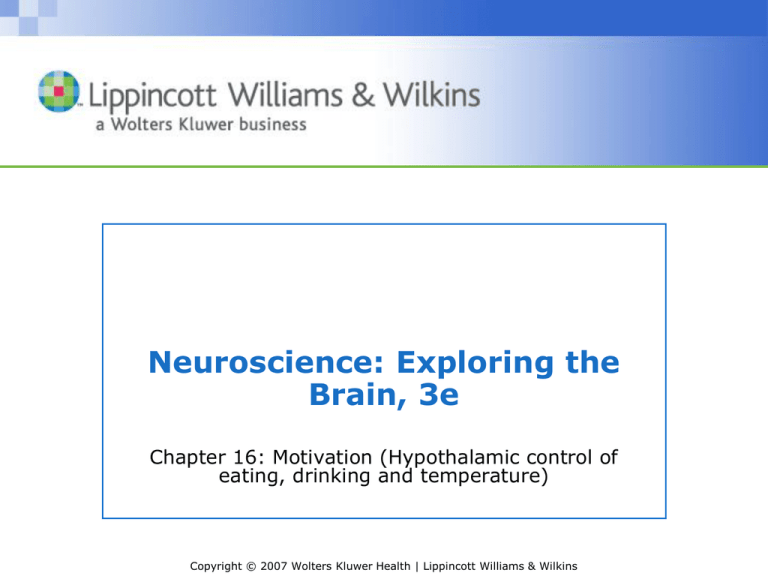
Neuroscience: Exploring the Brain, 3e Chapter 16: Motivation (Hypothalamic control of eating, drinking and temperature) Copyright © 2007 Wolters Kluwer Health | Lippincott Williams & Wilkins The Hypothalamus, Homeostasis, And Motivated Behavior • Homeostasis – Maintains the internal environment within a narrow physiological range • Role of Hypothalamus – Regulates homeostasis • Three components of neuronal response – Humoral response: Stim hormone release – Visceromotor response: Control autonomic N.S – Somatic motor response: Elicit regulatory behaviors Copyright © 2007 Wolters Kluwer Health | Lippincott Williams & Wilkins The Hypothalamus, Homeostasis, And Motivated Behavior (Cont’d) • Example of motivated behaviors – Response when body is cold • Body shivers, blood shunted away from the body surface, urine production inhibited, body fat reserves - mobilized – Lateral hypothalamus • Initiates motivation to actively seek or generate warmth - Homeostasis Copyright © 2007 Wolters Kluwer Health | Lippincott Williams & Wilkins The Long-term Regulation of Feeding Behavior • Energy Balance – Prandial state - Anabolism: Energy storage as glycogen and triglycerides – Postabsorptive state - Catabolism: Breaking down complex macromolecules Copyright © 2007 Wolters Kluwer Health | Lippincott Williams & Wilkins The Long-term Regulation of Feeding Behavior • Energy Balance Copyright © 2007 Wolters Kluwer Health | Lippincott Williams & Wilkins Hormonal and Hypothalamic Regulation of Body Fat and Feeding • Body Fat and Food Consumption – Lipostatic hypothesis – Parabiosis: e.g., Siamese twins – Leptin • Regulates body mass • Decreases appetite • Increases energy expenditure – Leptin depletion • Incites adaptive responses to fight starvation Copyright © 2007 Wolters Kluwer Health | Lippincott Williams & Wilkins Hormonal and Hypothalamic Regulation of Body Fat and Feeding • The Hypothalamus and Feeding – Anorexia: lateral hypothalamic syndrome – Obesity: ventromedial hypothalamic syndrome – Both related to leptin signaling Copyright © 2007 Wolters Kluwer Health | Lippincott Williams & Wilkins Hormonal and Hypothalamic Regulation of Body Fat and Feeding • The Hypothalamus and Feeding – Hypothalamic nuclei important for the control of feeding Copyright © 2007 Wolters Kluwer Health | Lippincott Williams & Wilkins Hormonal and Hypothalamic Regulation of Body Fat and Feeding • Response to Elevated Leptin Levels – Activation of arcuate neurons that release αMSH and CART peptides • Anorectic peptides- diminish appetite – Activation of arcuate neurons that release αMSH and CART peptides (Cont’d) • Project to regions that orchestrate coordinated response of humoral, visceromotor, and somatic responses • Paraventricular nucleus (humoral response) • Intermediolateral gray matter of spinal cord • Lateral hypothalamus Copyright © 2007 Wolters Kluwer Health | Lippincott Williams & Wilkins Hormonal and Hypothalamic Regulation of Body Fat and Feeding • Response to Elevated Leptin Levels Copyright © 2007 Wolters Kluwer Health | Lippincott Williams & Wilkins Hormonal and Hypothalamic Regulation of Body Fat and Feeding • Response to Decreased Leptin Levels – Activation of arcuate neurons that release NPY and AgRP (Leptin inhibits these cells) – Effects on energy balance: Opposite to the effects of αMSH and CART – Orexigenic peptides– increase appetite • NPY and AgRP inhibit secretion of TSH and ACTH • Activate parasympathetic division of ANS • Stimulate feeding behavior Copyright © 2007 Wolters Kluwer Health | Lippincott Williams & Wilkins Hormonal and Hypothalamic Regulation of Body Fat and Feeding • Response to Decreased Leptin Levels Copyright © 2007 Wolters Kluwer Health | Lippincott Williams & Wilkins Hormonal and Hypothalamic Regulation of Body Fat and Feeding • The Control of Feeding by Lateral Hypothalamic Peptides – LH neurons stimulating feeding behavior contain: • Melanin-concentrating hormone (MCH) • Orexin Copyright © 2007 Wolters Kluwer Health | Lippincott Williams & Wilkins Hormonal and Hypothalamic Regulation of Body Fat and Feeding • Summary: Anorectic and Orexigenic Peptides of the Hypothalamus Copyright © 2007 Wolters Kluwer Health | Lippincott Williams & Wilkins The Short-Term Regulation of Feeding Behavior • Model for short-term regulation of feeding – 3 phases: Cephalic; Gastric; Substrate Copyright © 2007 Wolters Kluwer Health | Lippincott Williams & Wilkins The Short-Term Regulation of Feeding Behavior • Model for short-term regulation of feeding – Cephalic: Hunger • Ghrelin released when stomach is empty • Activates NPY- and AgRP-containing neurons in arcuate nucleus Copyright © 2007 Wolters Kluwer Health | Lippincott Williams & Wilkins The Short-Term Regulation of Feeding Behavior • Model for short-term regulation of feeding – Gastric: Feeling full • Gastric distension signals brain via vagus • Works synergistically with CCK released in intestines in response to certain foods • Insulin also released by B cells of the pancreas important in anabolism Copyright © 2007 Wolters Kluwer Health | Lippincott Williams & Wilkins The Short-Term Regulation of Feeding Behavior • Model for short-term regulation of feeding – Changes in blood insulin levels before, during, and after a meal – Highest during “substrate” phase Copyright © 2007 Wolters Kluwer Health | Lippincott Williams & Wilkins Why Do We Eat? • Reinforcement and Reward – Liking: Hedonic – Wanting: Drive reduction – Electrical self-stimulation: Experiments to identify sites of reinforcement – Effective sites for self-stimulation: • Trajectory of dopaminergic axons in the ventral tegmental area projecting to the forebrain – Drugs that block dopamine receptors: Reduce selfstimulation Copyright © 2007 Wolters Kluwer Health | Lippincott Williams & Wilkins Why Do We Eat? • Mesocorticolimbic dopamine system Copyright © 2007 Wolters Kluwer Health | Lippincott Williams & Wilkins Why Do We Eat? • The Role of Dopamine in Motivation – Old belief: Dopamine projection served hedonic reward – New understanding • Dopamine-depleted animals “like” food but “do not want” food • Lack motivation to seek food, but enjoy it when available – Stimulation of the dopamine axons • Craving for food without increasing the hedonic impact Copyright © 2007 Wolters Kluwer Health | Lippincott Williams & Wilkins Why Do We Eat? • Changes in hypothalamic serotonin levels – Low:Postabsorptive period – Rise: In anticipation of food – Spike: During meals – Mood elevation - Rise in blood tryptophan and brain serotonin Copyright © 2007 Wolters Kluwer Health | Lippincott Williams & Wilkins Why Do We Eat? • The Role of Dopamine in Motivation – Serotonin, Food, and Mood (Cont’d) • Drugs that elevate serotonin levels • Example: Dexfenfluramine (Redux)- reduce appetite – Disorders: Anorexia nervosa; Bulimia nervosa both often accompanied by depression – Treatment • Antidepressant drugs—elevate brain serotonin levels • Example: Fluoxetine (“Prozac”) Copyright © 2007 Wolters Kluwer Health | Lippincott Williams & Wilkins Other Motivated Behaviors • Drinking: Pathways triggering volumetric thirst – Hypovolemia: Decrease in blood volume Copyright © 2007 Wolters Kluwer Health | Lippincott Williams & Wilkins Other Motivated Behaviors • Drinking: Pathway triggering osmotic thirst – Hypertonicity: Increased concentration of dissolved substances in blood (salt) Copyright © 2007 Wolters Kluwer Health | Lippincott Williams & Wilkins Other Motivated Behaviors • Drinking: Vasopressin - Antidiuretic hormone or ADH • Acts on kidneys to increase water retention • Inhibit urine production • Diabetes insipidus - loss of vasopressin Copyright © 2007 Wolters Kluwer Health | Lippincott Williams & Wilkins Other Motivated Behaviors • Temperature Regulation – Cells fine-tuned for constant temperature—37°C (98.6ºF) – Neurons for temperature homeostasis • Clustered in anterior hypothalamus • Humoral and visceromotor responses • Neurons in the medial preoptic area of the hypothalamus • Somatic motor (behavioral) responses • Neurons of lateral hypothalamic area Copyright © 2007 Wolters Kluwer Health | Lippincott Williams & Wilkins Other Motivated Behaviors • Temperature Regulation (Cont’d) – Process during a fall in temperature: TSH released by anterior pituitary TSH stimulates release of thyroxin from thyroid gland Increase in cellular metabolism – Visceromotor response: Goosebumps – Involuntary somatic motor response • Shivering, seeking warmth – Rise in temperature: Metabolism slowed by reducing TSH release Copyright © 2007 Wolters Kluwer Health | Lippincott Williams & Wilkins Other Motivated Behaviors • Temperature Regulation (Cont’d) – Hypothalmic responses to stimuli that motivate behavior Copyright © 2007 Wolters Kluwer Health | Lippincott Williams & Wilkins Concluding Remarks • Overview of motor systems – Addressed “how” questions of behavior • e.g., How is movement initiated? • Overview of motivation systems – Addresses “why” questions of behavior • e.g., mechanisms of motivation to drink when dehydrated? • The important discovery of a neural basis for feeding behavior – Allows us to frame new questions that will impact how we view our own behaviors Copyright © 2007 Wolters Kluwer Health | Lippincott Williams & Wilkins End of Presentation Copyright © 2007 Wolters Kluwer Health | Lippincott Williams & Wilkins Introduction • Types of behavior – Unconscious reflexes and Voluntary Movements – Motivation • Driving force on behavior • Analogy– ionic driving force dependent upon many factors • Probability and direction of behavior • Vary with the driving force needed to perform the behavior Copyright © 2007 Wolters Kluwer Health | Lippincott Williams & Wilkins
